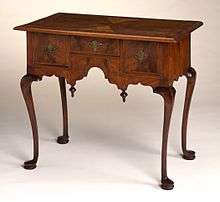Queen Anne style furniture

The Queen Anne style of furniture design developed before, during, and after the reign of Anne, Queen of Great Britain (1702–1714).
History and characteristics
Queen Anne furniture is "somewhat smaller, lighter, and more comfortable than its predecessors," and examples in common use include "curving shapes, the cabriole leg, cushioned seats, wing-back chairs, and practical secretary desk-bookcase pieces."[1] Other elements characterizing the style include pad feet and "an emphasis on line and form rather than ornament."[2] The style of Queen Anne's reign is sometimes described as late Baroque rather than "Queen Anne."[3][4]
The Queen Anne style began to evolve during the reign of William III of England (1689-1702),[5] but the term predominantly describes decorative styles from the mid-1720s to around 1760, although Queen Anne reigned earlier (1702-1714).[3][6] "The name 'Queen Anne' was first applied to the style more than a century after it was fashionable."[4] The use of Queen Anne styles in America, beginning in the 1720s and 1730s, coincided with new colonial prosperity and increased immigration of skilled British craftsmen to the colonies.[7][8][9] Some elements of the Queen Anne style remain popular in modern furniture production.[4]
Curved lines, in feet, legs, arms, crest rails, and pediments, along with restrained ornament (often in a shell shape) emphasizing the material, are characteristic of Queen Anne style.[4] In contrast to William and Mary furniture, which was marked by rectilinearity (straight lines) and use of curves for decoration, Queen Anne furniture uses C-scroll, S-scrolls, and ogee (S-curve) shapes in the structure of the furniture itself.[4] In sophisticated urban environments, walnut was a frequent choice for furniture in the Queen Anne style,[4] superseding the previously dominant oak and leading to the era being called "the age of walnut."[5] However, poplar, cherry, and maple were also used in Queen Anne style furniture.[10]
Ornamentation is minimal, in contrast to earlier 17th-century and William and Mary styles, which prominently featured inlay, figured veneers, paint, and carving. The cabriole leg is the "most recognizable element" of Queen Anne furniture.[11][5] Cabriole legs were influenced by the designs of the French cabinetmaker André-Charles Boulle[12] and the Rococo style from the French court of Louis XV.[13] But the intricate ornamentation of post-Restoration furniture was abandoned in favor more conservative designs, possibly under the influence of the simple and elegant lines of imported Chinese furniture.[12]
When decorative motifs or other ornamentation are used in Queen Anne-style furniture, it is often limited to carved scallop or shell or scroll-shaped motifs (sometimes in relief form and often found on the crest and knees),[4] broken and C-curves, and acanthus leaves.[14] The use of japanning is an exception to the general Queen Anne trend of minimal ornament.[4] When used, japanned decoration was frequently in red, green, or gilt on a blue-green field.[10]
The tilt-top tea table was first made during the Queen Anne period in 1774.[10]
Queen Anne eventually was eclipsed by the later Chippendale style; late Queen Anne and early Chippendale pieces are very similar, and the two styles are often identified with each together.[15][16][17]
Notes
- ↑ John F. Pile, A History of Interior Design (2nd ed.) Laurence King, 2005: p. 201.
- ↑ "Queen Anne style." The Grove Encyclopedia of Decorative Arts (Vol. 2). Oxford University Press, 2006: p. 246.
- 1 2 "Queen Anne style." The Grove Encyclopedia of Decorative Arts (Vol. 2).
- 1 2 3 4 5 6 7 8 Rosemary Troy Krill, Early American Decorative Arts, 1620-1860: A Handbook for Interpreters, p. 49.
- 1 2 3 Queen Anne style, Encyclopædia Britannica.
- ↑ R. Davis Benn, Style in Furniture (Longmans, Green & Co., 1904), p. 70 ("The style was founded in the reign of William III and Mary II, and retained its popularity throughout those of Anne and George the First, and nearly the whole of that of George the Second; nevertheless 'Queen-Anne' it was dubbed").
- ↑ American Furniture in the Metropolitan Museum of Art, Vol. 1, p. 108 (2007).
- ↑ In the 18th Century Style: Building Furniture Inspired by the Classical Tradition (Taunton Press, 2003), p. 20.
- ↑ Edwin Tunis, Colonial Craftsmen and the Beginnings of American Industry (Johns Hopkins University Press, 1999), p. 88 ("Anne became queen in 1702, but the sturdy furniture named for her was hardly known in America before 1725").
- 1 2 3 Zac Bissonnette, Warman's Antiques & Collectibles 2013 (46th ed. 2012).
- ↑ Beds and Bedroom Furniture. Taunton Press, 1997: p. 21.
- 1 2 Greene, Jeffrey P. (1996). American Furniture of the 18th Century: History, Technique, and Structure. Taunton Press. pp. 227–253. ISBN 978-1-56158-104-7.
- ↑ French Royal Furniture (c.1640-1792)
- ↑ Joseph Aronson, The Encyclopedia of Furniture (Random House, 1965), p. 192.
- ↑ Joseph Downs, American Furniture: Queen Anne and Chippendale Periods 1725-1788 (Schiffer Publishing, 2001).
- ↑ Collections: Decorative Arts: Armchair (William Savery), Brooklyn Museum.
- ↑ Good Furniture Magazine (Vol. 13), November 1919, p. 192.
References
- Blakemore, Robbie G. (2006). History of Interior Design and Furniture, From Ancient Egypt to Nineteenth-Century Europe. Hoboken, New Jersey: Wiley.
| Wikimedia Commons has media related to Queen Anne furniture. |